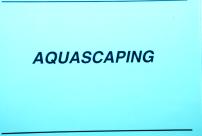 Slide 47
OK, now let's discuss some of the artistic aspects of planted tanks
- underwater flower arranging. For a professional view of this art, we
would suggest browsing some of the books by Takashi Amano entitled "Nature
Aquarium World". He is a professional artist and photographer
and does some incredible stuff with aquatic plants. But for the time being,
you'll have to make do with our humble efforts. We will show arrangements
and discuss some of the plants we use.
Slide 47
OK, now let's discuss some of the artistic aspects of planted tanks
- underwater flower arranging. For a professional view of this art, we
would suggest browsing some of the books by Takashi Amano entitled "Nature
Aquarium World". He is a professional artist and photographer
and does some incredible stuff with aquatic plants. But for the time being,
you'll have to make do with our humble efforts. We will show arrangements
and discuss some of the plants we use.
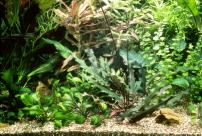 Slide 48
This is a nice scene in our 90 gallon tank. It has a nice variety of
contrasts of both color and shape and has a good composition that flows
from lower left to the middle right and back to the upper left. The center
piece plant is a Barclaya longifolia.
Slide 48
This is a nice scene in our 90 gallon tank. It has a nice variety of
contrasts of both color and shape and has a good composition that flows
from lower left to the middle right and back to the upper left. The center
piece plant is a Barclaya longifolia.
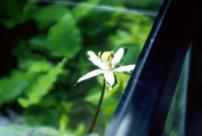 Slide 49
Another feature of the open-top tank is a chance to see aquatic plants
bloom . This is the flower of the Barclaya shown in the last slide. Note
that this a is 24" deep tank, so that plant really had to work to
get a flower to the surface.
Slide 49
Another feature of the open-top tank is a chance to see aquatic plants
bloom . This is the flower of the Barclaya shown in the last slide. Note
that this a is 24" deep tank, so that plant really had to work to
get a flower to the surface.
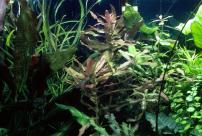 Slide 50
The larger pink plant is Ammannia senegalensis. This makes
a wonderful center piece and does well in warmer water. To the left is
an Echinodorus osiris. Notice the bubbles collecting under
the leaves - with strong light and proper nutrients, the plants are able
to supersaturate the water with oxygen. The plant with pink leaves and
white veins on the right is the "Sunset" variety of Hygrophila
polysperma - a very fast growing and undemanding plant.
Slide 50
The larger pink plant is Ammannia senegalensis. This makes
a wonderful center piece and does well in warmer water. To the left is
an Echinodorus osiris. Notice the bubbles collecting under
the leaves - with strong light and proper nutrients, the plants are able
to supersaturate the water with oxygen. The plant with pink leaves and
white veins on the right is the "Sunset" variety of Hygrophila
polysperma - a very fast growing and undemanding plant.
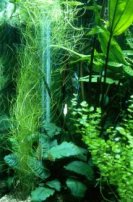 Slide 51
Here is a study in contrasts. To the far left is Elocharis acicularis
(Hairgrass). Below it is Anubias coffeeafolia, a very attractive
and rare form of Anubias (note the white flower spike). To the right is
Lysimachia nummularia (Money Penny). Each of these can be
used effectively as accent plants.
Slide 51
Here is a study in contrasts. To the far left is Elocharis acicularis
(Hairgrass). Below it is Anubias coffeeafolia, a very attractive
and rare form of Anubias (note the white flower spike). To the right is
Lysimachia nummularia (Money Penny). Each of these can be
used effectively as accent plants.
 Slide 52
Here is a close-up of an Anubias flower. We find that all the varieties
of Anubias that we have tried flower under water.
Slide 52
Here is a close-up of an Anubias flower. We find that all the varieties
of Anubias that we have tried flower under water.
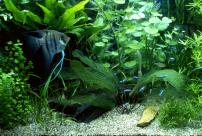 Slide 53
This is a good example of shape and texture contrasts. The Madagascar
Lace plant is a gorgeous centerpiece and is set off wonderfully by the
Hydrocotyle leucocephala behind it and the grassy Sagitarria
pusilla the foreground.
Slide 53
This is a good example of shape and texture contrasts. The Madagascar
Lace plant is a gorgeous centerpiece and is set off wonderfully by the
Hydrocotyle leucocephala behind it and the grassy Sagitarria
pusilla the foreground.
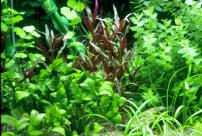 Slide 54
Texture, shape and color balance. The Alternanthera reineckii
will grow taller and bushier with time. The Bacopa caroliniana
on the right lends interesting shape and leaf pattern while the Armoracia
aquatica provides offsetting color and texture. To break up too
much "leafiness", grass-like Sagitarria pusilla
is used in the right foreground.
Slide 54
Texture, shape and color balance. The Alternanthera reineckii
will grow taller and bushier with time. The Bacopa caroliniana
on the right lends interesting shape and leaf pattern while the Armoracia
aquatica provides offsetting color and texture. To break up too
much "leafiness", grass-like Sagitarria pusilla
is used in the right foreground.
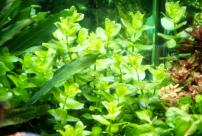 Slide 55
Here is a close-up of Bacopa caroliniana. It's bright
green fleshy leaves make this a great stem plant for either background
use or as an accent plant. It's a fast grower and is able to thrive with
under gravel filtration.
Slide 55
Here is a close-up of Bacopa caroliniana. It's bright
green fleshy leaves make this a great stem plant for either background
use or as an accent plant. It's a fast grower and is able to thrive with
under gravel filtration.
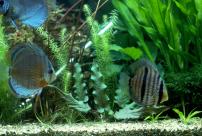 Slide 56
The Barclaya longifolia in the center is just going into
a rapid growth phase after sprouting from a bulb. With good conditions,
you can expect a new leaf and flower stem every couple of days. The Mayaca
fluviatilis behind it provides a great texture and color contrast.
Slide 56
The Barclaya longifolia in the center is just going into
a rapid growth phase after sprouting from a bulb. With good conditions,
you can expect a new leaf and flower stem every couple of days. The Mayaca
fluviatilis behind it provides a great texture and color contrast.
Two wild-type discus are shown: a "Green" on the left and a "Heckel" on the right. The bottom half of a "Brilliant Turquoise" is seen at the upper left.
 Slide 57
Cryptocoryne species are very popular and do well in tanks
with less than optimal lighting. They grow well in tanks with a soil substrate
as well as the less troublesome gravel/laterite substrate. This is a variant
of the common C. wendtii.
Slide 57
Cryptocoryne species are very popular and do well in tanks
with less than optimal lighting. They grow well in tanks with a soil substrate
as well as the less troublesome gravel/laterite substrate. This is a variant
of the common C. wendtii.
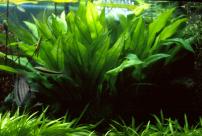 Slide 58
An Amazon sword plant, Echinodorus bleheri, in full health.
This magnificent plant is perfect for a larger tank. In this case, the
plant "owns" 1/3 of a 100 gallon discus tank. What started as
a single plant has split into four separate plants at the base and has
produced large quantities of plantlets on flower stalks. This is a true
"Mother Plant".
Slide 58
An Amazon sword plant, Echinodorus bleheri, in full health.
This magnificent plant is perfect for a larger tank. In this case, the
plant "owns" 1/3 of a 100 gallon discus tank. What started as
a single plant has split into four separate plants at the base and has
produced large quantities of plantlets on flower stalks. This is a true
"Mother Plant".
 Slide 59
This is a red variant of Echinodorus horemanii. New leaves
forming in the center are a brilliant rust red. Older leaves become blue-green.
This plant can become huge given the proper conditions and will form a
long rhizome. As the plant grows, new leaves form at the leading edge of
the rhizome, causing it to "move" in the tank. This specimen
started in the left rear corner and is now midway to the front center of
the tank.
Slide 59
This is a red variant of Echinodorus horemanii. New leaves
forming in the center are a brilliant rust red. Older leaves become blue-green.
This plant can become huge given the proper conditions and will form a
long rhizome. As the plant grows, new leaves form at the leading edge of
the rhizome, causing it to "move" in the tank. This specimen
started in the left rear corner and is now midway to the front center of
the tank.
We remove it when it gets too big (or moves to the wrong location). You can cut sections off the older part of the rhizome, partially submerge them in the gravel and multiple new plants will form from the bumps on the rhizome.
 Slide 60
This is a nice example of an Echinodorus osiris. It too
can get very large and may start to grow emersed. This plant produced 13"
long submersed leaves for quite a while. One day, it produced what looked
like a flower stalk that headed for the surface. The stalk turned out to
be an emersed leaf and all leaves thereafter grew above the surface.
Slide 60
This is a nice example of an Echinodorus osiris. It too
can get very large and may start to grow emersed. This plant produced 13"
long submersed leaves for quite a while. One day, it produced what looked
like a flower stalk that headed for the surface. The stalk turned out to
be an emersed leaf and all leaves thereafter grew above the surface.
Just behind the osiris are some leaves from a E. major. It grows long and thin like the E. horemanii but is a much brighter green.
 Slide 61
There are quite a few plants that are suitable for foreground use. Echinodorus
quadricostatus makes a nice mat at the front of the tank. Depending
on light and nutrients, it can stay small (under 2") or grow to 8"
tall. It quickly spreads via runners. When the patch gets too thick, we
pull the whole mass up, vacuum the surface layer of the gravel, pick out
8 or 10 robust "mother plants" and replant them.
Slide 61
There are quite a few plants that are suitable for foreground use. Echinodorus
quadricostatus makes a nice mat at the front of the tank. Depending
on light and nutrients, it can stay small (under 2") or grow to 8"
tall. It quickly spreads via runners. When the patch gets too thick, we
pull the whole mass up, vacuum the surface layer of the gravel, pick out
8 or 10 robust "mother plants" and replant them.
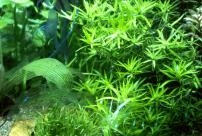 Slide 62
Heteranthera zosteraefolia is a beautiful bunch plant
that can grow very quickly and can fill a corner of the tank. It is a sensitive
plant, however, and will develop black spots and bad leaves if conditions
aren't right.
Slide 62
Heteranthera zosteraefolia is a beautiful bunch plant
that can grow very quickly and can fill a corner of the tank. It is a sensitive
plant, however, and will develop black spots and bad leaves if conditions
aren't right.
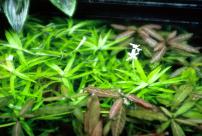 Slide 63
When H. zosteraefolia is happy, it will reach the top
and produce delicate little pale purple flowers. Views like this make a
open top tank very worthwhile.
Slide 63
When H. zosteraefolia is happy, it will reach the top
and produce delicate little pale purple flowers. Views like this make a
open top tank very worthwhile.
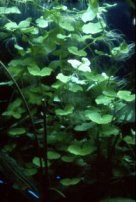 Slide 64
Hydrocotyle leucocephala makes a great background plant
or an impressive centerpiece. We plant one end and let the other end trail
up to and across the surface. Roots quickly develop at each leaf node and
provide excellent places for Rainbowfish to scatter eggs.
Slide 64
Hydrocotyle leucocephala makes a great background plant
or an impressive centerpiece. We plant one end and let the other end trail
up to and across the surface. Roots quickly develop at each leaf node and
provide excellent places for Rainbowfish to scatter eggs.
 Slide 65
Here is a top view of L. leucocephala growing among a
group of emersed E. osiris leaves. All we need now are some
tiny frogs to sit atop the "lily pads"!
Slide 65
Here is a top view of L. leucocephala growing among a
group of emersed E. osiris leaves. All we need now are some
tiny frogs to sit atop the "lily pads"!
 Slide 66
Another excellent background or centerpiece plant is Hygrophila
corymbosa or Temple Plant. It is a very fast grower that also will
do well with an undergravel filter.
Slide 66
Another excellent background or centerpiece plant is Hygrophila
corymbosa or Temple Plant. It is a very fast grower that also will
do well with an undergravel filter.
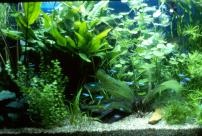 Slide 67
Here is an overall shot of a 90 gallon tank with a very nice arrangement.
Background, foreground and center elements nicely balance each other with
a harmonious range of color, texture and height.
Slide 67
Here is an overall shot of a 90 gallon tank with a very nice arrangement.
Background, foreground and center elements nicely balance each other with
a harmonious range of color, texture and height.
 Slide 68
This is a beautiful water lily, Nymphea stellata, used
as a center piece. The contrast between it's huge round leaves and the
other plants around it is striking.
Slide 68
This is a beautiful water lily, Nymphea stellata, used
as a center piece. The contrast between it's huge round leaves and the
other plants around it is striking.
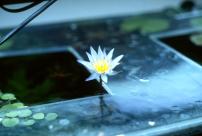 Slide 69
The lily surprised us one day and produced a single, perfect flower.
It's too bad this tank had a full hood.
Slide 69
The lily surprised us one day and produced a single, perfect flower.
It's too bad this tank had a full hood.
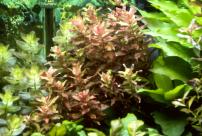 Slide 70
A very popular stem plant, for obvious reasons, is the Rotala
macrandra. With good light and nutrients, it is a fast growing
and colorful plant. The leaves towards the top will take on a brilliant
pink-orange color. We have found that cutting off the upper 1/3 and replanting
just the top is the best way to maintain a healthy stock. If you leave
the lower 2/3 planted, it will form multiple top shoots but the lower part
will become less robust. However, itís a good way to increase your population.
Slide 70
A very popular stem plant, for obvious reasons, is the Rotala
macrandra. With good light and nutrients, it is a fast growing
and colorful plant. The leaves towards the top will take on a brilliant
pink-orange color. We have found that cutting off the upper 1/3 and replanting
just the top is the best way to maintain a healthy stock. If you leave
the lower 2/3 planted, it will form multiple top shoots but the lower part
will become less robust. However, itís a good way to increase your population.
 Slide 71
A smaller species of Rotala is the R. rotundifolia.
It also tends towards pink at the top and can self-propagate. It has the
characteristic of forming horizontal stems that quickly form roots and
produce new vertical stems. Left unchecked, it becomes a weed!
Slide 71
A smaller species of Rotala is the R. rotundifolia.
It also tends towards pink at the top and can self-propagate. It has the
characteristic of forming horizontal stems that quickly form roots and
produce new vertical stems. Left unchecked, it becomes a weed!
 Slide 72
Another nice foreground plant is Samolus parviflorus or
Water Cabbage. The main plant stays fairly low and has a nice pale green
color. Although some references say it won't propagate in the aquarium,
we have had no problem with it. A stem will form in the middle of the rosette
and new baby plants will form on the stem (seen here on the middle plant).
The stem can get to 12" high and will produce teeny round flowers.
Slide 72
Another nice foreground plant is Samolus parviflorus or
Water Cabbage. The main plant stays fairly low and has a nice pale green
color. Although some references say it won't propagate in the aquarium,
we have had no problem with it. A stem will form in the middle of the rosette
and new baby plants will form on the stem (seen here on the middle plant).
The stem can get to 12" high and will produce teeny round flowers.
 Slide 73
Java Fern, Microsorium pteropus, is a very popular and
undemanding plant. We like to put it in darker corners on pieces of rock
or driftwood. It needs massive pruning every six months or it will form
a compacted mass. We will lop off large pieces of the rhizome and reattach
the best looking part.
Slide 73
Java Fern, Microsorium pteropus, is a very popular and
undemanding plant. We like to put it in darker corners on pieces of rock
or driftwood. It needs massive pruning every six months or it will form
a compacted mass. We will lop off large pieces of the rhizome and reattach
the best looking part.
 Slide 74
Hygrophila difformis, Water Sprite, is a fast growing
plant that can be used effectively as a background or centerpiece plant.
Slide 74
Hygrophila difformis, Water Sprite, is a fast growing
plant that can be used effectively as a background or centerpiece plant.
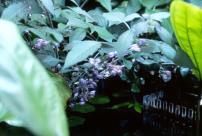 Slide 75
This is the emersed form of Hygrophila corymbosa. Once
it becomes emersed, the underwater part becomes mostly stems (much like
mangrove roots). It blooms continuously with pretty purple flowers.
Slide 75
This is the emersed form of Hygrophila corymbosa. Once
it becomes emersed, the underwater part becomes mostly stems (much like
mangrove roots). It blooms continuously with pretty purple flowers.
 Slide 76
Another view of the Rainbowfish tank with an undergravel filter. Stem
plants do very well in this tank. Notice the Samolus parviflorus
in the left center with the tall stems supporting baby plants. Hygrophila
corymbosa is behind it with a small E. horemanii
just of the left of center.
Slide 76
Another view of the Rainbowfish tank with an undergravel filter. Stem
plants do very well in this tank. Notice the Samolus parviflorus
in the left center with the tall stems supporting baby plants. Hygrophila
corymbosa is behind it with a small E. horemanii
just of the left of center.
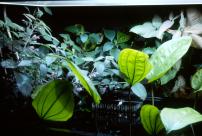 Slide 77
Here are emersed E. osiris leaves in front of emersed
H. corymbosa. Houseplants are on a shelf behind the tank.
Is that a jaguar peering out of the jungle?
Slide 77
Here are emersed E. osiris leaves in front of emersed
H. corymbosa. Houseplants are on a shelf behind the tank.
Is that a jaguar peering out of the jungle?
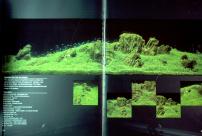 Slide 78
This is one of Takashi Amano's "paintings" using aquatic plants.
He strives to create scenes from nature using aquascaping elements. Using
just rocks and Glossostigma elatinoides, he has beautifully
represented a mountain scene.
Slide 78
This is one of Takashi Amano's "paintings" using aquatic plants.
He strives to create scenes from nature using aquascaping elements. Using
just rocks and Glossostigma elatinoides, he has beautifully
represented a mountain scene.
 Slide 79
If your aquascaped aquarium is like a piece of art, it makes sense to
frame it appropriately. We had some oak stands and hoods custom built to
match other furniture in the house. Surprisingly, they weren't that much
more expensive than standard high quality stands found at aquarium stores.
We located a local woodworking shop and worked with them to develop the
design.
Slide 79
If your aquascaped aquarium is like a piece of art, it makes sense to
frame it appropriately. We had some oak stands and hoods custom built to
match other furniture in the house. Surprisingly, they weren't that much
more expensive than standard high quality stands found at aquarium stores.
We located a local woodworking shop and worked with them to develop the
design.
The hood is a bit different than you find in aquarium shops. It is split in the middle so that the front half swings up and over the back half. This gives us easy access to the tank for feeding, cleaning and maintenance. The whole hood slides back 4" to the wall, allowing full access without removing it completely. Fluorescent lights and an on/off switch are mounted in the hood.
 Slide 80
As a final note, we would like to slip in a reference to the Aquatic
Gardeners Association. This is a hobbyist association devoted to aquatic
plants. They publish a newsletter roughly six times per year with loads
of information on the aquatic plant hobby. See the handout for information
about joining.
Slide 80
As a final note, we would like to slip in a reference to the Aquatic
Gardeners Association. This is a hobbyist association devoted to aquatic
plants. They publish a newsletter roughly six times per year with loads
of information on the aquatic plant hobby. See the handout for information
about joining.
Another worthwhile reference is the Aquatic Plants Digest, available via http://www.actwin.com.